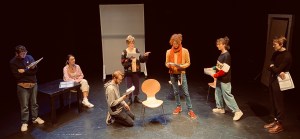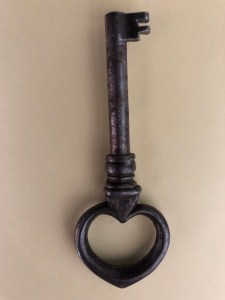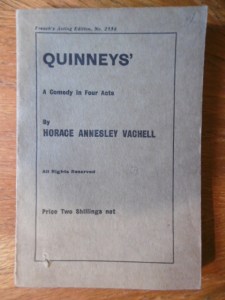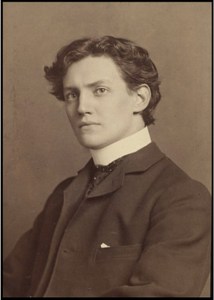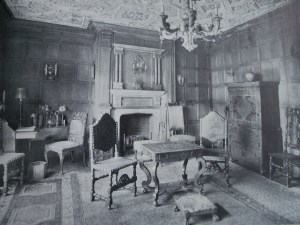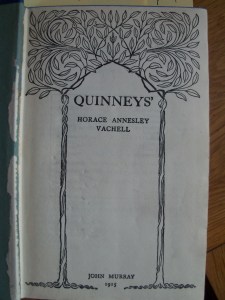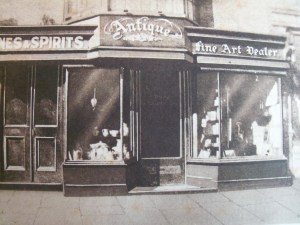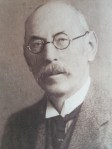Our rehearsals for the performance of Quinneys are continuing apace – (the play is to be staged at The Witham, Barnard Castle, on Saturday 28th March – to book tickets, click to the weblink to The Witham here). George Rodosthenous, (Director of the theatre and performance BA/MA programmes at the University of Leeds), and the director of the play, has been ramping up the number of rehearsals over the last two weeks, as the student actors begin to inhabit their characters in ever increasing degrees of authenticity! Here (below) is one of George’s professional black and white photographs of (almost) the full cast of Quinneys (only Jake, who has recently joined the cast to play the part of Dupont Jordan, is absent…but you can see Jake further in this blog post, below) – in the photo below are, left to right, India (Mable Dredge, Quinney’s typist), Stephenson (Cyrus P. Hunsaker, American millionaire collector), Annabel (Posy, Quinney’s daughter) on Fergus’s (James, Quinney’s foreman) knee; with Samuel (Quinney) and Hannah (Mrs Susan Quinney) behind, and Morgan (Sam Tomlin, fellow antique dealer) to the right.
And here’s the cast in rehearsals again, this time without Samuel (Quinney) but with Jake Pursell (playing the role of the American millionaire collector, Dupont Jordan) in the centre, on his knees examining a chair – Jake is an MA student, and has immediately immersed himself in the role…being from Texas, USA, himself!
In the photograph (below) Jake (Dupont) and Stephenson (as Cyrus P. Hunsaker, another American collector in the play), greet Annabel (Posy), with India (Mable) and Fergus (James) to the right – and George, directing the play (but here playing Quinney). In the foreground is an inanimate ‘actor’, (a reproduction ‘Persian’ vase) taking the part of the rare ‘Kang Hsi, mirror-black bottle’ that also stars in the play.
Indeed, in this week’s rehearsals we used some stand-in props for the real antiques that we will be using as part of the set for the play. In the 1910 and 1920s, when Quinneys was first performed, several leading antique dealers, such as Moss Harris and Walter Thornton-Smith, provided appropriate antiques for the set – and for our performance at The Witham, we have been lucky that several antique dealers, and also the Bowes Museum itself, have agreed to loan antiques for the play. For rehearsals of course, we need ‘stand-ins’, and in the photograph (below), Samuel (Quinney) and Stephenson (Hunsaker) discuss a rare Charles II walnut armchair (which will be on loan from the Bowes Museum) using a large blown-up photograph (fixed to the cream seminar room chair, between them) of the very chair that will be in the performance!
We did manage to use one real antique in the rehearsals – a 19th century key, one that Posy places in the Kang Hsi ‘mirror black, bottle’ and which opens an antique lacquer cabinet that is one of the stars of the show (in terms of inanimate objects at least) and into which she has placed a love letter to James – and here’s the very key – appropriately, given that it is the key that opens a cabinet into which a love letter rests, shaped like a ‘heart’!
One of the aspects of the performance that we will be debating and discussing in the proposed workshop on Sunday 29th March – the day following the re-staging of Quinneys – is the complexity of the idea of ‘authenticity’ in a workshop titled ‘Dealing with Authenticity’ and led by our colleague Professor Jonathan Pitches (Professor of Performance at the University of Leeds) – so having the actors working with ‘fake’ antiques, and then working with the genuine thing, will be something we might ruminate upon; as well, of course, as what it means to embody, to become, a character in a play as part of a performance.
Indeed, what is especially interesting (for me) is that the fictional character of the antique dealer Joseph Quinney is actually based on a real life antique dealer, called Thomas Rohan, who was trading in Bournemouth and Southampton at the time that Horace Vachell composed his play (and associated novel) – and, as if to reinforce the point, here is Samuel, holding a photocopy of a photograph of Thomas Rohan, of about 1920 – Samuel becoming Thomas Rohan, becoming Joseph Quinney!
And here’s a few more photographs of the student actors in rehearsals – they are all fantastic actors and are performing brilliantly – you will miss something special if you don’t get to see the play!….seats are going fast, so do book before they all go!
And finally, an amusing shot, from an amusing scene in the play, with Annabel (Posy) and Fergus (James) in foreground, with Samuel (Quinney) and Hannah (Mrs Quinney) in the background, sneaking a look at the two young lovers – (in the play, the whiteboard will be an 18th century Chinese lacquer screen…..we hope!)
Mark

Annabel (Posy) and Fergus (James), with Samuel (Quinney) and Hannah (Mrs Quinney) in the background – rehearsals for Quinneys.

